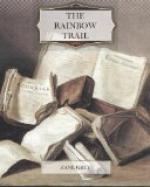The first Indians to put in an appearance were a flock of children, half naked, with tangled manes of raven-black hair and skin like gold bronze. They appeared bold and shy by turns. Then a little, sinewy man, old and beaten and gray, came out of the principal hogan. He wore a blanket round his bent shoulders. His name was Hosteen Doetin, and it meant gentle man. His fine, old, wrinkled face lighted with a smile of kindly interest. His squaw followed him, and she was as venerable as he. Shefford caught a glimpse of the shy, dark Glen Naspa, Nas Ta Bega’s sister, but she did not come out. Other Indians appeared, coming from adjacent hogans.
Nas Ta Bega turned the mustangs loose among those Shefford had noticed, and presently there rose a snorting, whistling, kicking, plunging melee. A cloud of dust hid them, and then a thudding of swift hoofs told of a run through the cedars. Joe Lake began picking over stacks of goat-skins and bags of wool that were piled against the hogan.
“Reckon we’ll have one grand job packing out this load,” he growled. “It’s not so heavy, but awkward to pack.”
It developed, presently, from talk with the old Navajo, that this pile was only a half of the load to be packed to Kayenta, and the other half was round the corner of the mountain in the camp of Piutes. Hosteen Doetin said he would send to the camp and have the Piutes bring their share over. The suggestion suited Joe, who wanted to save his burros as much as possible. Accordingly, a messenger was despatched to the Piute camp. And Shefford, with time on his hands and poignant memory to combat, decided to recall his keen interest in the Navajo, and learn, if possible, what the Indian’s life was like. What would a day of his natural life be?
In the gray of dawn, when the hush of the desert night still lay deep over the land, the Navajo stirred in his blanket and began to chant to the morning light. It began very soft and low, a strange, broken murmur, like the music of a brook, and as it swelled that weird and mournful tone was slowly lost in one of hope and joy. The Indian’s soul was coming out of night, blackness, the sleep that resembled death, into the day, the light that was life.
Then he stood in the door of his hogan, his blanket around him, and faced the east.
Night was lifting out of the clefts and ravines; the rolling cedar ridges and the sage flats were softly gray, with thin veils like smoke mysteriously rising and vanishing; the colorless rocks were changing. A long, horizon-wide gleam of light, rosiest in the center, lay low down in the east and momentarily brightened. One by one the stars in the deep-blue sky paled and went out and the blue dome changed and lightened. Night had vanished on invisible wings and silence broke to the music of a mockingbird. The rose in the east deepened; a wisp of cloud turned gold; dim distant mountains showed dark against the red; and low down in a notch a rim of fire appeared. Over the soft ridges and valleys crept a wondrous transfiguration. It was as if every blade of grass, every leaf of sage, every twig of cedar, the flowers, the trees, the rocks came to life at sight of the sun. The red disk rose, and a golden fire burned over the glowing face of that lonely waste.




